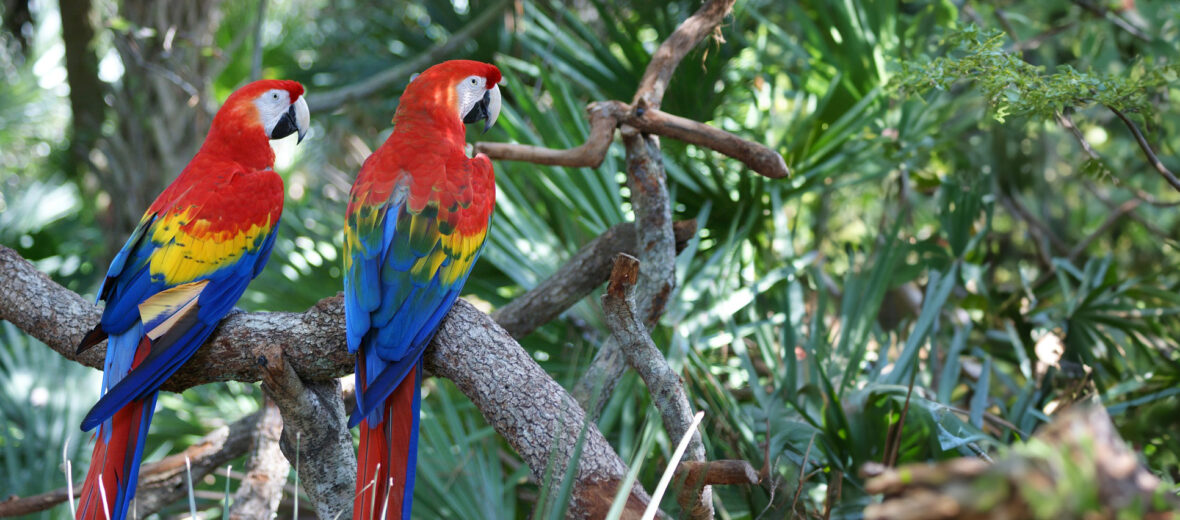
The scarlet macaw hails from Mexico, Central America, and South America. They prefer humid lowland subtropical rainforests, mangrove vegetation, river edges, open woodlands, and savannas. The only main threats to these large and colorful birds is that of habitat destruction and loss, due to deforestation from the logging industry; and occasional trapping for the exotic pet trade. These birds number an estimated 499,999 wild individuals. Their numbers are decreasing though. These macaws are listed as Least Concern by the IUCN. This is Critter Science’s 1,500th article! Enjoy!
First the Stats…
Scientific name: Ara macao
Weight: Up to 2.2 lbs.
Length: Up to 39 inches, including their tail feathers
Wingspan: Up to 47 inches
Lifespan: Up to 75 years
Now on to the Facts!
1.) Scarlet macaws are diurnal (active during the day).
2.) These birds are social and gather into large flocks at night to rest and also gather to find food.
3.) They tend to be left side dominant (favor their left foot when grasping items).
4.) A group of macaws is called a company, flock, or pandemonium.
5.) While predominantly herbivorous (eat plant matter), these birds can also venture into the omnivore category, as they not only feast on fruits (especially the polewood fruit), seeds, nuts, flowers, nectar, and foliage, but also happily eat insects and grubs.
But wait, there’s more on the scarlet macaw!
6.) These critters are monogamous (mate for life). They are barely ever seen by themselves, unless gathering food for their partner who happens to be incubating their eggs.
7.) Bonding is strengthened by mutual preening and licking each other’s faces.
Did you know…?
There is 1 macaw that is 124 years old! It was hatched in 1899!
8.) Females lay up to 4 eggs that hatch in up to 25 days.
9.) The chicks stay with their parents for up to 2 years.
10.) Both parents care for their chicks, but the female primarily incubates the eggs.
But wait, there’s still more on the scarlet macaw!
11.) Another clutch of eggs is not laid until the previous clutch has fledged and dispersed.
12.) Males are called a cock, females are called a hen, and the young are called chicks.
Did you know…?
Honduras has the scarlet macaw as it’s national bird.
13.) Scarlet macaws have been bred in captivity since the 11th century.
14.) The first captive breeding took place in Paquime, in Northern Mexico.
15.) Using their powerful beaks, the Scarlet macaw can even break open Brazil nuts.
Don’t go away, there’s still a little more on the scarlet macaw!
16.) They also use their large beaks as a climbing aid.
17.) Even though their vocal talents pale in comparison to the African grey parrot, they can still skillfully mimic voices and various sounds. These critters can also learn a variety of tricks, with a little patience.
18.) Scarlet macaws are also able to differentiate various colors and shapes. Some have even been taught basic math.
19.) Their intelligence is said to be that of up to an 8 year old child. But their emotional level is that of a 2 year old. So, yes, they will throw tantrums and be naughty if unattended or neglected in any way.
20.) These birds can typically learn upwards of 30 words, plus they can also duplicate and create numerous sounds.
Now a Short Scarlet Macaw Video!
Be sure to share & comment below! Also, check out the Critter Science YouTube channel. Videos added regularly!
Want to suggest a critter for me to write about? Let me know here.
Some source material acquired from: Wikipedia & IUCN



